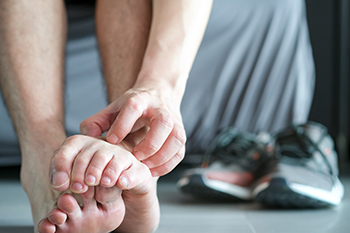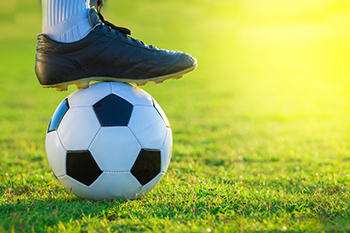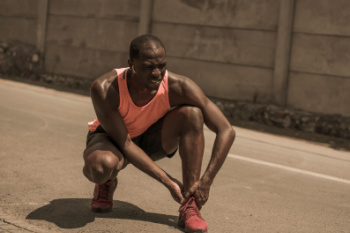August 2024
Athlete’s Foot Treatments

Athlete's foot is a fungal infection affecting the skin on the feet, often caused by the fungus tinea pedis. It thrives in warm and moist environments, making public showers, locker rooms, and swimming pools prime locations for infection. The condition typically causes itching, redness, and scaling between the toes, and can sometimes spread to the soles of the feet. The primary cause is exposure to the fungus, which can be contracted from contaminated surfaces or by sharing footwear. Individuals with sweaty feet or compromised immune systems are at higher risk. To address athlete's foot, start with antifungal treatments, available as creams, powders, or sprays. Keeping feet clean and dry is key and you should wash your feet daily, dry thoroughly, and change socks frequently. Wearing breathable, moisture-wicking socks and avoiding tight, non-ventilated shoes can also help. For persistent or severe cases of athlete's foot, it is suggested you schedule an appointment with a podiatrist for a more advanced treatment plan, which may include prescribed medication.
Athlete’s foot is an inconvenient condition that can be easily reduced with the proper treatment. If you have any concerns about your feet and ankles, contact one of our podiatrists from Family Foot Care. Our doctors will treat your foot and ankle needs.
Athlete’s Foot: The Sole Story
Athlete's foot, also known as tinea pedis, can be an extremely contagious foot infection. It is commonly contracted in public changing areas and bathrooms, dormitory style living quarters, around locker rooms and public swimming pools, or anywhere your feet often come into contact with other people.
Solutions to Combat Athlete’s Foot
- Hydrate your feet by using lotion
- Exfoliate
- Buff off nails
- Use of anti-fungal products
- Examine your feet and visit your doctor if any suspicious blisters or cuts develop
Athlete’s foot can cause many irritating symptoms such as dry and flaking skin, itching, and redness. Some more severe symptoms can include bleeding and cracked skin, intense itching and burning, and even pain when walking. In the worst cases, Athlete’s foot can cause blistering as well. Speak to your podiatrist for a better understanding of the different causes of Athlete’s foot, as well as help in determining which treatment options are best for you.
If you have any questions please feel free to contact our offices located in Valatie and Albany, NY . We offer the newest diagnostic and treatment technologies for all your foot and ankle needs.
Bunion Complications

A bunion is a bony bump that forms on the joint at the base of the big toe, often causing the toe to deviate towards the others. Common issues can include chronic pain, bursitis or inflammation of the fluid-filled pads that cushion the bones, and metatarsalgia or pain and inflammation in the ball of the foot. Severe cases or complications can lead to hammertoes or crossover toes, where toes bend abnormally, and even arthritis in the big toe joint. Preventing bunion complications involves wearing properly fitted shoes with a wide toe box, avoiding high heels, and using orthotic inserts to reduce pressure on the bunion. Maintaining a healthy weight can also alleviate stress on the feet. Treatment options range from non-surgical methods like padding and medications to manage pain to surgical procedures for more severe cases. If you have a bunion that is causing worsening symptoms, it is suggested that you promptly consult a podiatrist who can help to manage symptoms and prevent further complications.
If you are suffering from bunions, contact one of our podiatrists of Family Foot Care. Our doctors can provide the care you need to keep you pain-free and on your feet.
What Is a Bunion?
A bunion is formed of swollen tissue or an enlargement of boney growth, usually located at the base joint of the toe that connects to the foot. The swelling occurs due to the bones in the big toe shifting inward, which impacts the other toes of the foot. This causes the area around the base of the big toe to become inflamed and painful.
Why Do Bunions Form?
Genetics – Susceptibility to bunions are often hereditary
Stress on the feet – Poorly fitted and uncomfortable footwear that places stress on feet, such as heels, can worsen existing bunions
How Are Bunions Diagnosed?
Doctors often perform two tests – blood tests and x-rays – when trying to diagnose bunions, especially in the early stages of development. Blood tests help determine if the foot pain is being caused by something else, such as arthritis, while x-rays provide a clear picture of your bone structure to your doctor.
How Are Bunions Treated?
- Refrain from wearing heels or similar shoes that cause discomfort
- Select wider shoes that can provide more comfort and reduce pain
- Anti-inflammatory and pain management drugs
- Orthotics or foot inserts
- Surgery
If you have any questions, please feel free to contact our offices located in Valatie and Albany, NY . We offer the newest diagnostic and treatment technologies for all your foot care needs.
Types and Prevention of Ankle Injuries in Soccer

Ankle injuries are prevalent in soccer due to the sport's fast-paced, high-impact nature. Common injuries include sprains, where ligaments are stretched or torn, and strains, affecting the muscles or tendons around the ankle. Achilles tendonitis, an inflammation of the tendon that connects the calf to the heel, is also common. Prevention is key to avoiding these injuries. Wearing properly fitted soccer shoes with good ankle support helps reduce the risk of sprains and strains. Strengthening and flexibility exercises, such as ankle circles and calf stretches, can enhance ankle stability and resilience. Employing proper techniques, including correct foot positioning and avoiding excessive twisting movements, also contributes to injury prevention. Regular warm-ups and conditioning are vital for maintaining overall foot and ankle health during the rigorous demands of soccer. If you have suffered an ankle injury while playing soccer, it is suggested that you consult a podiatrist who can offer you treatment and injury prevention techniques.
Sports related foot and ankle injuries require proper treatment before players can go back to their regular routines. For more information, contact one of our podiatrists of Family Foot Care. Our doctors can provide the care you need to keep you pain-free and on your feet.
Sports Related Foot and Ankle Injuries
Foot and ankle injuries are a common occurrence when it comes to athletes of any sport. While many athletes dismiss the initial aches and pains, the truth is that ignoring potential foot and ankle injuries can lead to serious problems. As athletes continue to place pressure and strain the area further, a mild injury can turn into something as serious as a rupture and may lead to a permanent disability. There are many factors that contribute to sports related foot and ankle injuries, which include failure to warm up properly, not providing support or wearing bad footwear. Common injuries and conditions athletes face, including:
- Plantar Fasciitis
- Plantar Fasciosis
- Achilles Tendinitis
- Achilles Tendon Rupture
- Ankle Sprains
Sports related injuries are commonly treated using the RICE method. This includes rest, applying ice to the injured area, compression and elevating the ankle. More serious sprains and injuries may require surgery, which could include arthroscopic and reconstructive surgery. Rehabilitation and therapy may also be required in order to get any recovering athlete to become fully functional again. Any unusual aches and pains an athlete sustains must be evaluated by a licensed, reputable medical professional.
If you have any questions please feel free to contact our offices located in Valatie and Albany, NY . We offer the newest diagnostic and treatment technologies for all your foot and ankle needs.
Gout Pain Can Be Managed
Gout Pain Can Be Managed
What is a High Ankle Sprain?
 A high ankle sprain, also known as a syndesmotic sprain, involves injury to the ligaments connecting the tibia and fibula above the ankle joint. Unlike common ankle sprains affecting the ligaments on the outer side of the ankle, high ankle sprains result from a twisting or rotational force, often occurring during sports involving sudden changes in direction. Symptoms include pain above the ankle, swelling, bruising, and difficulty in bearing weight. Diagnosis typically involves a physical examination and imaging tests like X-rays or MRI scans to assess the extent of ligament damage and to ensure there are no associated fractures. Treatment typically starts with rest, compression, and elevation. Severe cases may require immobilization with a cast or boot and, in some instances, surgery to repair torn ligaments. Recovery can be longer than a typical ankle sprain, ranging from several weeks to a few months, depending on the severity and treatment approach. If you believe you may have endured a high ankle sprain, it is suggested that you schedule an appointment with a podiatrist for a proper diagnosis and treatment.
A high ankle sprain, also known as a syndesmotic sprain, involves injury to the ligaments connecting the tibia and fibula above the ankle joint. Unlike common ankle sprains affecting the ligaments on the outer side of the ankle, high ankle sprains result from a twisting or rotational force, often occurring during sports involving sudden changes in direction. Symptoms include pain above the ankle, swelling, bruising, and difficulty in bearing weight. Diagnosis typically involves a physical examination and imaging tests like X-rays or MRI scans to assess the extent of ligament damage and to ensure there are no associated fractures. Treatment typically starts with rest, compression, and elevation. Severe cases may require immobilization with a cast or boot and, in some instances, surgery to repair torn ligaments. Recovery can be longer than a typical ankle sprain, ranging from several weeks to a few months, depending on the severity and treatment approach. If you believe you may have endured a high ankle sprain, it is suggested that you schedule an appointment with a podiatrist for a proper diagnosis and treatment.
Although ankle sprains are common, they aren’t always minor injuries. If you need your ankle injury looked at, contact one of our podiatrists from Family Foot Care. Our doctors can provide the care you need to keep you pain-free and on your feet.
How Does an Ankle Sprain Occur?
Ankle sprains are the result of a tear in the ligaments within the ankle. These injuries may happen when you make a rapid shifting movement while your foot is planted. A less common way to sprain your ankle is when your ankle rolls inward while your foot turns outward.
What Are the Symptoms?
- Pain at the sight of the tear
- Bruising/Swelling
- Ankle area is tender to touch
- In severe cases, may hear/feel something tear
- Skin discoloration
Preventing a Sprain
- Wearing appropriate shoes for the occasion
- Stretching before exercises and sports
- Knowing your limits
Treatment of a Sprain
In many cases, the RICE method (Rest, Ice, Compression, and Elevate) is used to treat ankle sprains. However, you should see a podiatrist to see which treatment option would work best with your injury. In severe cases, surgery may be required.
It is important to ask your doctor about rehab options after you receive treatment for your injury. Stretching, strength training, and balance exercises may help the ankle heal while also preventing further injury.
If you have any questions, please feel free to contact our offices located in Valatie and Albany, NY . We offer the newest diagnostic and treatment technologies for all your foot care needs.




